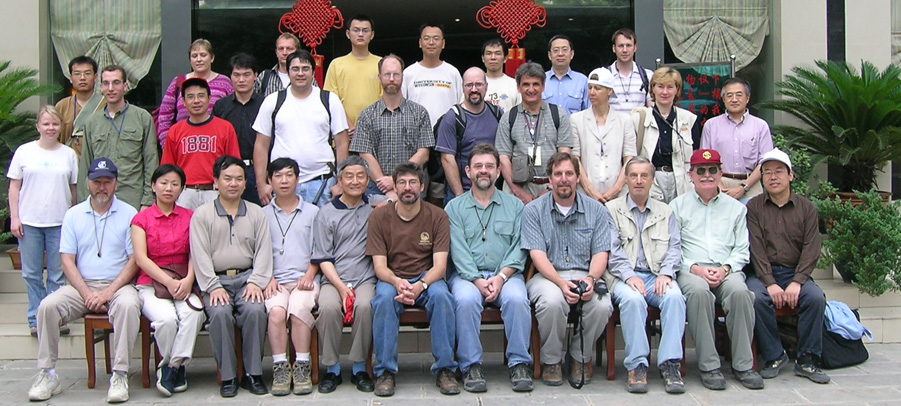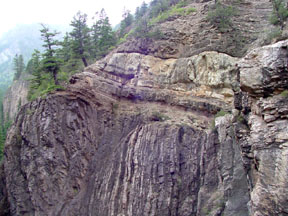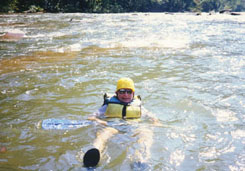| Official portrait of the participants on the post-meeting fieldtrip to the Great Bank of Guizhou. |  |
FIELDTRIPS & WORKSHOPS
Thomas J. Algeo
Professor of Geology
University of Cincinnati
•
Permo-Triassic Chronostratigraphy & Early Triassic Biotic Recovery
Conference, China; May 17-June 3, 2005
| Official portrait of the participants on the post-meeting fieldtrip to the Great Bank of Guizhou. |  |
| Margin of the Great Bank of Guizhou, an exhumed carbonate platform of mostly Triassic age. Photo courtesy of Dan Lehrmann. |
|
Fieldtrip participants at the Rungbao section, Great Bank of Guizhou. This interval consists largely of Lower Triassic microbialites and oolitic-oncolitic grainstones. |
• U.C. Geology: Regional geology of southern Rockies &
Colorado Plateau; Sept. 4-16, 2002
|
This two-week trip through the heart of the Colorado Rockies and eastern Utah included numerous sites of geologic interest: Rocky Mountain N.P., Arches N.P., Canyonlands N.P., Great Sand Dunes N.M., Florissant Fossil Beds N.M., Red Rocks State Park, Royal Gorge, the Paradox Valley, the San Juan Mountains, and Pikes Peak Batholith. Special events included a ride on the Durango-Silverton Narrow-Gauge Railroad through the Animas Canyon, and tours of the Bachelor-Syracuse silver mine in Ouray, Colorado, and the Mollie Kathleen gold mine in Cripple Creek, Colorado. |
|
|
|
Students enjoying a spectacular view in Canyonlands National Park. |
| Buttes along Utah Route 211, entering the Needles District of Canyonlands National Park. The prominent cliff-former is the Wingate Sandstone; the slope below consists of the Chinle and Moenkopi formations. |  |
 |
Unconformity at Box Canyon Falls, near Ouray, Colorado. The near-vertical strata below belong to the Late Proterozoic Uncompahgre Group; the overlying gently inclined strata are Devonian-age sandstones. |
| Boarding the Durango-Silverton narrow-gauge steam railroad at Silverton, Colorado. The train descends through the spectacular Animas Canyon, in the heart of the San Juan Mountains. |
|
|
Guidebook: Algeo, T.J., ed., 2002, Geology of the Southern Rocky Mountains & Colorado Plateau: University of Cincinnati, Dept. of Geology, ca. 200 p. |
|
• U.C. Geology: Foreland clastics of eastern Kentucky & central West Virginia; Sept. 27-30, 2001
| Each fall the U.C. Geology Dept. runs a Four-Day Fieldtrip for all grad students & faculty; alumni and undergrads are welcome to participate as well. The 2001 excursion, with guest field leaders Thomas Kammer of West Virginia University and Mitch Blake of the West Virginia Geological Survey, examined foreland basin deposits of the Late Devonian Acadian and Middle-Late Pennsylvanian Alleghenian orogenies in eastern Kentucky and central West Virginia. A new perspective on the Nuttall Sandstone was gained by rafting down the Gauley River, replete with Class IV and V rapids. | |
|
|
Route map for Sept. 2001 fieldtrip to the New River Gorge area of central West Virginia. |
|
David Meyer during rafting trip. |
 |
| Guidebook: Algeo, T.J., ed., 2001, Sedimentology & Sequence Stratigraphy of Foreland Basin Deposits of the Acadian & Alleghenian Orogenies, Central Appalachian Basin: University of Cincinnati, Dept. of Geology, 101 p. | |
• U.C. Geology: Modern carbonate environments of the Florida Keys; Mar. 18-26, 2000
|
This trip, held at Spring Break, is run in conjunction with a Spring Quarter course: Advanced Carbonate Sedimentology (GEOL 604). The goal is to introduce students to the range of facies, sediments, and biotas encountered in modern tropical marine environments such as the Florida Keys. The trip entails two days of snorkeling on the reef tract at John Pennecamp State Park as well as outcrop work in the Key Largo Limestone. A day in Key West provides for relaxation. |
|
|
|
Group photo next to banyon tree, Lignum Vitae Key Nature Preserve. |
|
Sea turtle, part of the abundant biota encountered on the outer reef tract at John Pennecamp State Park. |
|
|
Snorkeling off Indian Key. Professor Algeo is on the right. |
|
Guidebook: Algeo, T.J., ed., 1998, Carbonate Environments, Sediments & Biota of the Florida Keys: University of Cincinnati, Dept. of Geology, ca. 120 p. |
• SEPM-GLS & KSPG Field Conference, Cincinnati, OH:
Sequence, Cycle & Event
Stratigraphy of Mid-Paleozoic Strata of the Cincinnati Arch; October
8-10, 1999
|
This fieldtrip examined the classic Upper Ordovician Cincinnatian Series in recent roadcuts along the AA Highway (KY Rte. 9) in northern Kentucky. The Kope Formation has been interpreted as a series of limestone tempestites (storm deposits) separated by mudstone layers representing background sedimentation, but recent work by Algeo and Brett, in collaboration with several U.C. graduate students, has shown that this model is oversimplified. In particular, abundant evidence suggests that the limestones may be "time-rich," representing prolonged episodes of reworking, while the mudstones are "time-poor," having accumulated in rapid succession—at odds with the existing "paradigm". Reexamination of this classic succession is offering new insights on shallow marine sedimentation processes and controls on stratigraphic accumulation. |
|
|
|
Route map for the Oct. 1999 SEPM-GLS and KSPG field conference along the AA Highway between Cincinnati, Ohio and Maysville, Kentucky. |
| Exposure of the Pioneer Valley, Snag Creek, and Alexandria submembers of the Kope Fm. at AA Highway outcrop 33. |
| Soft-sediment deformation (ball-and-pillow structures) in calcisiltites of the upper Fairview Fm. along KY Route 11, east of Maysville, Kentucky. | |
|
Guidebook: Algeo, T.J., and Brett, C.E., eds., 2001, Sequence, Cycle & Event Stratigraphy of Upper Ordovician & Silurian Strata of the Cincinnati Arch Region, Field Trip Guidebook, 1999 Field Conference of the Great Lakes Section of the Society for Sedimentary Geology (SEPM-SSG) and the Kentucky Society of Professional Geologists (KSPG): Lexington, Kentucky, Kentucky Geological Survey, 144 p. |
|
• AAPG Eastern Section/TSOP Annual Meeting, Lexington, KY: Paleozoic Black Shales; Sept. 27-28, 1997
| This combined fieldtrip/core workshop considered modern approaches to analysis of black shale depositional environments. Algeo and Maynard, together with several U.C. graduate students, developed an innovative approach combining X-radiography with XRD, XRF, DOP, and C and S isotopic analysis. This event reviewed results of this research on Upper Devonian black shales of the Appalachian Basin and Upper Pennsylvanian black shales of the Midcontinent. | |
| Guidebook: Algeo, T.J., and Maynard, J.B., 1997, Cyclic Sedimentation of Appalachian Devonian and Midcontinent Pennsylvanian Black Shales: Analysis of Ancient Marine Anoxic Systems: University of Cincinnati, Dept. of Geology, 147 p. |